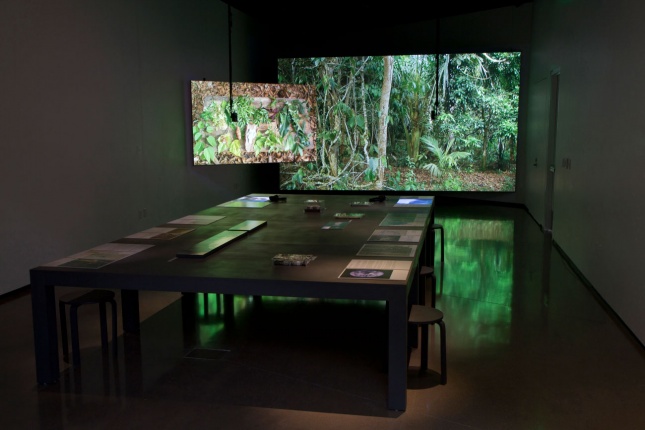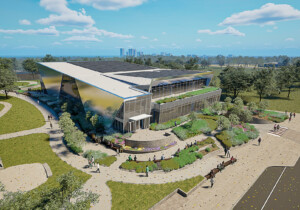Chicago-based curator and writer Yesomi Umolu will curate the 2019 Chicago Architecture Biennial. Her unique combination of experience in architectural design and curatorial practice will give her a refreshing take on the program, which has served as a barometer for what is happening in the U.S. and abroad.
The Architect’s Newspaper: What is your background, and what brought you to the Chicago Biennial?
Yesomi Umolu: So my background is in architectural design. I studied it and I worked in practice for a couple of years in the U.K. at Grimshaw, which is a big high-tech practice, and then at a smaller practice called Haworth Tompkins, doing a lot of collaborations with artists, including Dan Graham with his Waterloo Sunset Pavilion at the Hayward Gallery in London. I was working on projects that represented my passion for the arts. Eventually, I went on to curating contemporary art, but kept my foot in the architecture world through my network. I think the types of narratives and discourses that I was interested in were more related to spatial practices and how both architects and artists were dealing with those issues.
What brought you to Chicago?
I got a job as exhibitions curator at the Logan Center for the Arts at the University of Chicago. So I’ve been in the U.S. for about seven years. I was at the Walker Art Center in Minneapolis before that, and then at the Broad Art Museum at Michigan State in East Lansing. I’ve worked in really nice buildings: Herzog & De Meuron [at the Walker] and then Zaha Hadid [at the Broad], and now Todd Williams and Billie Tsien [at the Logan Center]. So I have been lucky to be surrounded by good architecture.

In transitioning from practice to curation, where would you find yourself in relation to the last two Biennials?
I would come at it by thinking about space as an inherently political medium and exploring the way in which we make spaces. Spaces are not necessarily neutral things; there are power dynamics at play. Then there are the different sorts of audiences and visitors to those spaces. The critic Jane Rendell coined the term “critical spatial practice,” which was about how one makes spaces and thinks about the politics behind them. She particularly wrote about the relationship between art and architecture, and how architects had a role to play—not just in the building of cultural buildings, but in the formation of cultural spaces, and that their skills could be lent to those spaces as well.
Today there are people like Shumon Basar, Eyal Weizman, and other artists who have taken up the helm. I worked with Brad Butler and Karen Mirza, who are in the Weizman architecture school of thought in London, as well as a whole host of others. So that’s where I would kind of situate myself. Broadly speaking, my work has always been interested in questions of globalization, which of course have a spatial articulation to them as well, whether it’s thinking about the flows of people, resources, or money, and how that affects the spaces in which we live and work.

So it sounds like there will be some continuity with the last two Biennials.
Yeah, exactly. So I think that’s what I can bring to the table: my particular interest in the Global South and also maybe greater access to it as well.
So what can we expect in 2019 at the third CAB?
Instead of having an idea and just having people funnel into that, I want to create the best team that’s going to help establish a very rigorous conversation through a project of R&D for the next three to six months or so, and a curatorial idea will follow.
The role that arts and culture play is obviously something I’m going to be very, very interested in. Secondly, with the Biennial, obviously the last two editions have had folks that have been super embedded in the discipline, whereas it’s nice to have an individual such as myself who has roots in the discipline but can come at it from a slight tangent.
I think how we define public space is really important right now—how to redefine participation in public space, and how arts or architecture can be leveraged to encourage more public participation. I’m also really interested in that, thinking about how architecture is communicated from the space of school to the space of practice. I can’t say for sure that it’s going to be like X, but these are my interest areas.

What are some of the shows you have curated that might give insight into your thoughts and process?
I did a show recently with two Brazilian artists: an artist called Cinthia Marcelle and a filmmaker called Tiago Mata Machado. They’ve been working together for the last five to seven years doing a series of beautiful minimalist videos that look at the social space in Brazil and raise questions of revolution and chaos. These films usually focus on a specific piece of urban fabric or furniture, and then they orchestrate a series of pseudo-performances around that. So we did a show with them this last September that brought together these four video pieces. I think that resonates in terms of thinking about public space, and again, agency, collectivities, and how space can be activated through either political protest or revolution. Also, I did a show recently with Kapwani Kiwanga, who is a Paris-based Canadian artist with a background in comparative religions and ethnography. So she usually mines in a particular history and particular archives and then creates from that. And she was looking at the histories of disciplinary spaces across the world and their sort of legacies and how they affect human behavior and perception.
This interview will appear in the upcoming issue 10 of AN Interior.











